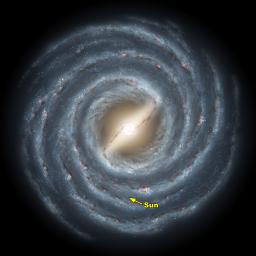

|
Astronomy 162:
Introduction to Stars, Galaxies, & the Universe
Prof. Richard Pogge, MTWThF 9:30
|
Lecture 23: The Milky Way
Readings: Ch 25, Section 25-1
- The Milky Way is our Galaxy
- Diffuse band of light crossing the sky
- Galileo: Milky Way consists of many faint stars
- The Nature of the Milky Way
- Philosophical Speculations: Wright & Kant
- Star Counts: Herschels & Kapteyn
- Globular Cluster Distribution: Shapley
The Milky Way
Diffuse band of light crossing the night sky.
All human cultures have named it:
- a Celestial River
- a Celestial Road or Path
Our words "Galaxy" and "Milky Way" are derived from Greek
and Latin:
- Greek: Galaxias kuklos = "Milky Band"
- Latin: Via Lactea = "Road of Milk"
"The Starry Messenger"
Galileo (1610):
- Galileo observed the Milky Way with his new telescope.
- Published his findings in his pamphlet, Siderius Nuncius
(The Starry Messenger)
- "For the Galaxy is nothing else than a congeries of innumerable
stars distributed in clusters."
This was the first observation that showed that the Milky Way was simply
made of many many unresolved faint stars.
Philosophical Interlude
Thomas Wright (1750):
- Picture motivated by theological considerations
- Wright made no new observations.
Model:
- Milky Way is a thin spherical shell of stars.
- The Sun is located inside the shell about midway between the
inner and outer edges.
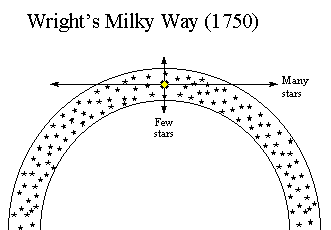
- [Section of Wright's original woodcut]
From our location near the Sun:
- Looking along the shell: See a broad band of stars ("Milky Way")
- Look out along the thin part of the shell: See few stars
A Theory of the Heavens
Immanuel Kant (1755):
- Misread a newspaper account of Wright's model.
- Also made no observations of his own.
Model:
- Lens-shaped disk of stars rotating about its center.
- No special place for the Sun.
- Other "nebulae" are distant, rotating milky ways
like ours.
Later became known as the "Island Universe" Hypothesis
(term coined by Alexander von Humboldt, Kosmos, 1845).
The Herschels' Star Gages
William & Caroline Herschel (1785):
- Counted stars along 683 lines of sight using their 20-foot long,
19-inch diameter telescope.
- Assumed that stars are uniformly distributed through space, and
do not extend beyond the edges of the Milky Way.
- Assumed that their telescope could resolve all stars within
the boundaries of the Milky Way.
Contrary to some accounts (including your textbook!), Herschel did not
need to assume that all stars are the same luminosity for his Star
Gage method to work. He did make this assumption in other
work, however, hence the confusion by some (copying the same
mistake from each other?).
Model:
- Flattened Milky Way ("grindstone")
- Sun located very near the center.
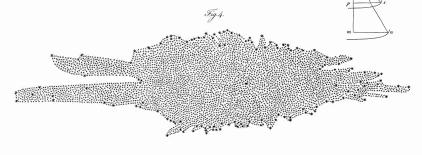
- The Milky Way Map of William Herschel. Click to
see a larger version.
Figure 4 from On the Construction of the Heavens by
William Herschel, published in Philosophical Transactions of the Royal
Society of London, Vol. 75 (1785), pp. 213-266. Image scanned
by the author.
The Kapteyn Universe
Jacobus Kapteyn (1901 thru 1922):
- Used photographic star counts
- Estimated distances statistically based on parallaxes &
proper motions of nearby stars.
- Neglected interstellar absorption of starlight (assumes that
stars were faint only because they far away, not because interstellar
absorption blocks some of the light).
Model:
- Milky Way is a flattened disk ~15 kpc across & ~3 kpc thick
- The Sun is located slightly off-center.
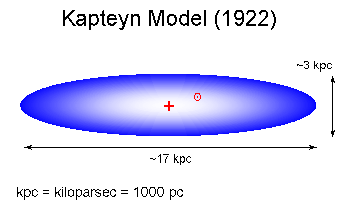
- Sketch based on Kapteyn's paper.
Harlow Shapley (1915 thru 1921)
Astronomer at the Harvard College Observatory who was working
on the nature of Globular Clusters of Stars.
Shapley noted two facts about Globular Clusters:
- They are uniformly distributed above & below the plane of the
Milky Way.
- They are concentrated on the sky toward the direction of the
constellation of Sagittarius, where the Milky Way appears brightest.
Observations:
- Estimated Globular Cluster distances from observations of their
RR Lyrae stars and their
magnitudes and diameters.
- Used these distances to map the globular cluster distribution in space.
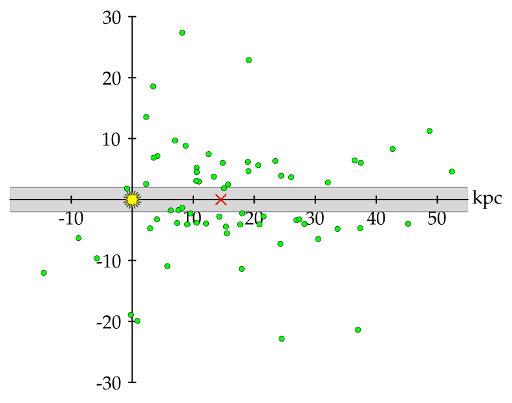
- Graph based on Shapley's original 1918 globular cluster data.
The Sun is located at the center of the axes as the yellow sun symbol,
and the center of the Milky Way inferred from the distribution of
globular clusters is marked by the red X at about 15kpc from the Sun.
The gray horizontal band is a region of obscuration noted by Shapley.
The Greater Milky Way
Shapley's Results (1921):
- Globular clusters form a subsystem centered on the Milky Way.
- The Sun is ~15 kpc from the MW center.
- MW is a flattened disk ~100 kpc across
Right basic result, but too big:
- Shapley ignored interstellar absorption
- Caused him to overestimate the distances.
The Problem of Absorption
Absorption of Starlight by Interstellar Dust:
- Interstellar space is filled with gas and dust
- This dust absorbs and scatters starlight passing through it,
- This makes more distant objects look fainter than they
otherwise would be if there were no interstellar dust.
- If left unaccounted for, it can lead to serious
overestimates of
Luminosity Distances.
Absorption by Interstellar Dust affects all attempts to map the Milky Way:
- Shapley & Kapteyn thought it was smaller than it actually
is, and so overestimated the size of the Milky Way.
- Robert Trumpler (1930) showed that interstellar dust absorption
was significant.
The Milky Way
Our present view of the Milky Way today is largely Shapley's model, but
corrected for the effects of interstellar absorption:
Return to [
Unit 4 Index
|
Astronomy 162 Main Page
]
Updated: 2007 March 6
Copyright © Richard W. Pogge, All Rights Reserved.







